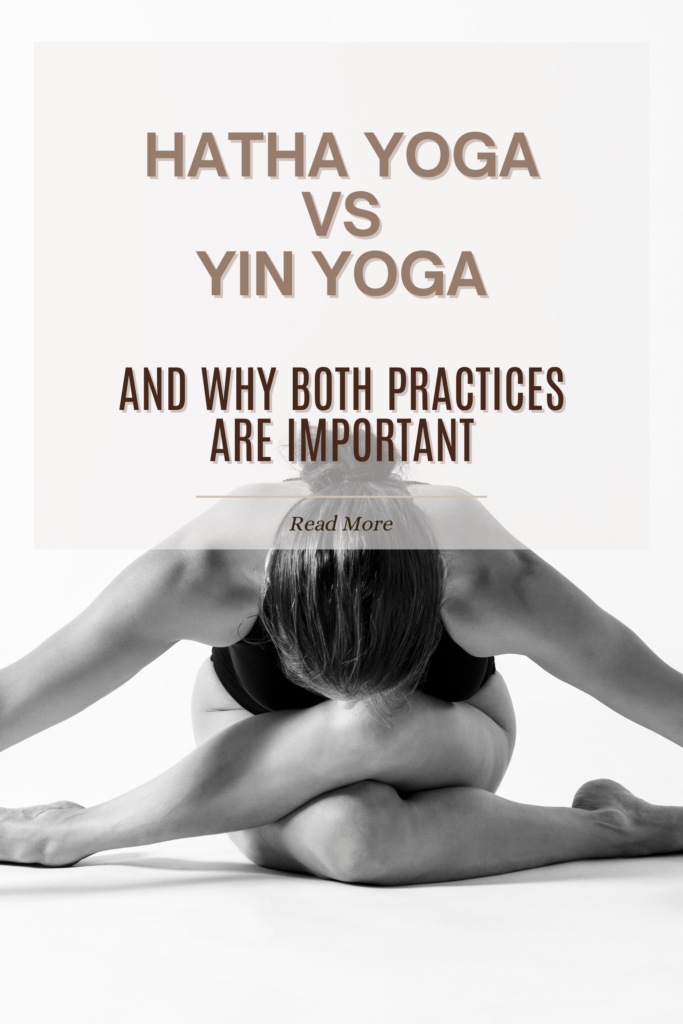Hatha Yoga VS Yin Yoga and why both practices are important

Hatha Yoga

Hatha yoga, originating thousands of years ago in Nepal and India, focuses on moving slowly in sync with breath for clarity and inner peace.
Each posture in this ancient practice offers unique healing benefits.
Unlike the faster pace of vinyasa or ashtanga yoga classes, Hatha yoga sessions typically progress at a slower tempo.
Despite not being as fast-paced, this practice still prompts sweat due to long holds in poses that require muscle engagement and core strength.
I am a yoga teacher based in California so obviously this practice isn’t going to be the same as the ancient practices and it will have my own touch on it as well.
But, I have given my students a feel to know what hatha yoga stands for and the inner teachings through the poses, yoga philosophies and the music I play during my classes. I try to translate what is most important in the hatha yoga classes.
Key Points:
Yin Yoga

Yin yoga is a quiet contemplative practice.
Yin yoga works deeply into our body with passive, longer-held poses.
It targets the deepest tissues of the body, our connective tissues – ligaments, joints, bones, the deep fascia networks of the body and the meridians. This is contrast to a Yang yoga practice such as Vinyasa yoga which targets the muscles.
Energetically, Yin yoga improves the energy flow, enhancing the flow of chi in the organs. To be healthy, we need healthy organs as well as healthy muscles.
Yin yoga also offers wonderful emotional and mental health benefits.
Yin yoga originates from China and Taiwan over 2000 years ago. It relates to the old teachings from Daoist Yoga known as Dao Yin.
Yin yoga poses are usually held from 3-5 minutes to really allow your body to settle into the poses and almost bring you into a meditative state and stretches your tissues and your fascia.
Yin yoga can be for all levels depending on how intricate the poses can get just like any other type of yoga class. Each pose has a specific healing benefit and each is unique in it’s own way.
Key Points:
What makes both of these practices similar?

Both styles encourage practitioners to connect with their breath, bringing attention to each inhale and exhale to cultivate a sense of presence and inner calm.
Another similarity is their emphasis on holding poses for extended periods. In hatha yoga, practitioners hold poses to build strength, flexibility, and endurance, while in yin yoga, poses are held for several minutes to target the deep connective tissues and promote relaxation and release.
This extended holding of poses in both practices allows for a deeper exploration of the body and the mind, fostering a meditative state and a greater understanding of one’s physical and mental capabilities.
Key points:
What makes both of these practices different and unique?

One key difference between hatha and yin yoga is the pace and intensity of the practice. Hatha yoga typically involves holding poses for a shorter duration, moving through sequences with a focus on building strength and flexibility.
In contrast, yin yoga poses are held for longer periods, often up to several minutes, allowing for a deep release of tension in the muscles and joints.
Another distinction lies in the intention behind the practices. Hatha yoga aims to create balance and harmony in the body, mind, and spirit, promoting overall well-being and vitality.
On the other hand, yin yoga targets the deeper tissues in the body, such as ligaments, tendons, and fascia, helping to improve flexibility, joint mobility, and circulation.
Both hatha and yin yoga offer valuable benefits for practitioners of all levels, from beginners to experienced yogis.
Whether you prefer a dynamic and energizing practice like hatha yoga or a gentle and introspective practice like yin yoga, incorporating both styles into your routine can provide a well-rounded yoga experience that nurtures both the physical and mental aspects of your being.
Key Points:
For more info on online classes and course

I am very passionate about yoga and learning different styles of yoga really allows me to honor different parts of myself. I would love to share my yoga classes that incorporate my own twist on these practices.





